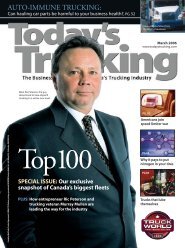Create successful ePaper yourself
Turn your PDF publications into a flip-book with our unique Google optimized e-Paper software.
Technological<br />
Whack-a-mole<br />
Engine emissions can’t be approached in isolation.<br />
But can anyone see the whole picture?<br />
Asurge in heavy-truck orders at the tail end of 2009 tells<br />
us that we just saw a mild version of the pre-buy phenomenon<br />
that so disrupted the market in years past.<br />
Troublesome though some 2007-spec and earlier engines have<br />
been—and let’s face it, some have been bad—the known devil can<br />
become a handsome, almost kindly beast when the alternative is<br />
perceived as a more or less complete stranger who could turn out<br />
to be a monster. But the real killer, of course, is the significantly<br />
higher price tag of a truck sporting a 2010 engine. Who wants to<br />
spend an extra $10,000 for the right to haul freight at discounted<br />
rates? Who can?<br />
<strong>In</strong> three successive rounds of emission rules arising out of the<br />
mighty U.S. Environmental Protection Agency (EPA) since 2002,<br />
truck buyers have forked out an accumulated engine “surcharge”<br />
of well over $20,000 while also spending more on fuel, maintenance,<br />
and downtime. Significantly more in some cases. As<br />
recipes for success go, I’ve seen better.<br />
Yep, the air’s cleaner, and you could stick your nose into the<br />
exhaust stack of a 2010 engine and breathe deeply without ill<br />
effect, but we’ve had to suck more crude oil out of the ground—<br />
or squeeze it out of Alberta dirt—<br />
to do it. And I’m not just talking<br />
about lost fuel economy here.<br />
I mean lost improvements to<br />
fuel economy that we couldn’t<br />
make because every mechanical<br />
engineer and chemist on the<br />
planet was engaged in fooling<br />
“And that’s the real<br />
bottom line: I fear<br />
that we’ve reached<br />
the limits of human<br />
ingenuity.”<br />
with air intake and injection pressure and who knows what else<br />
to get emissions in line with EPA demands. These folks could<br />
have been refining the combustion process and software dudes<br />
could have been creating new algorithms to gain a mile or two per<br />
gallon. <strong>In</strong>stead they were busting their butts trying to limit the<br />
efficiency losses while creating a clean exhaust stream.<br />
But the engineering waste doesn’t stop there. Talk, for example,<br />
to the boys at Eaton and ask how many truck makers have<br />
engineered the latest UltraShift transmission into their chassis.<br />
It’s a terrific gearbox and it can save a buck on the fuel front but<br />
almost nobody’s had the resources to send it to the data book. Or<br />
By Rolf Lockwood<br />
Editorial<br />
at least it’s been a far, far slower process than it should have been.<br />
Yeah, yeah, let’s save the planet. Sure, I do agree, but what I<br />
want to see is a comprehensive effort that moves all the pieces on<br />
the chess board in a complete game. What we’ve done is focus<br />
simple-mindedly on shifting specific pieces without acknowledging<br />
how they change everything else. Frankly, nobody seems to<br />
see the whole board, and it may well be beyond the basically<br />
linear human mind to do so.<br />
And that’s the real bottom line: I fear that we’ve reached the<br />
limits of our ingenuity.<br />
SWITCHING RANTS, WHAT ABOUT PARKING? Surely this<br />
one isn’t beyond us. I’ve written before about the horrible lack of<br />
parking spaces for logbook-limited drivers, and now Transport<br />
Canada is working to measure the problem. The first effort is to<br />
establish an inventory of existing truck parking spaces across the<br />
country, and the second is to establish the extent of the shortage<br />
with a truck driver survey.<br />
It aims to define drivers’ parking habits and preferences while<br />
pinpointing areas of the country where designated truck parking<br />
might be tough to find. I could tell them, but they also want to<br />
figure out how any shortages might have an impact on “safety,<br />
productivity, and personal well-being.”<br />
Any driver who runs in Canada should fill out this online survey<br />
(see below) because the shortages are real and if we don’t get a<br />
high level of participation, it’ll send a message to the regulators<br />
that drivers accept the parking situation as it is. The survey gives<br />
drivers the chance to make suggestions and recommendations<br />
on where parking might be needed.<br />
It’s the first time drivers have had such an opportunity,<br />
so I urge you to tell your guys about it. The survey is live online<br />
now, and paper copies are available for anybody without<br />
access to a computer. Call 800-333-0371 and choose option<br />
2 in the automated menu, or visit www.surveymonkey.com/<br />
truckparkingcanada.<br />
I think this is extremely important so please do something<br />
about it now. And hey, Happy New Year. ▲<br />
Rolf Lockwood is vice president, editorial, at Newcom Business Media.<br />
You can reach him at 416-614-5825 or rolf@todaystrucking.com.<br />
JANUARY 2010 9



